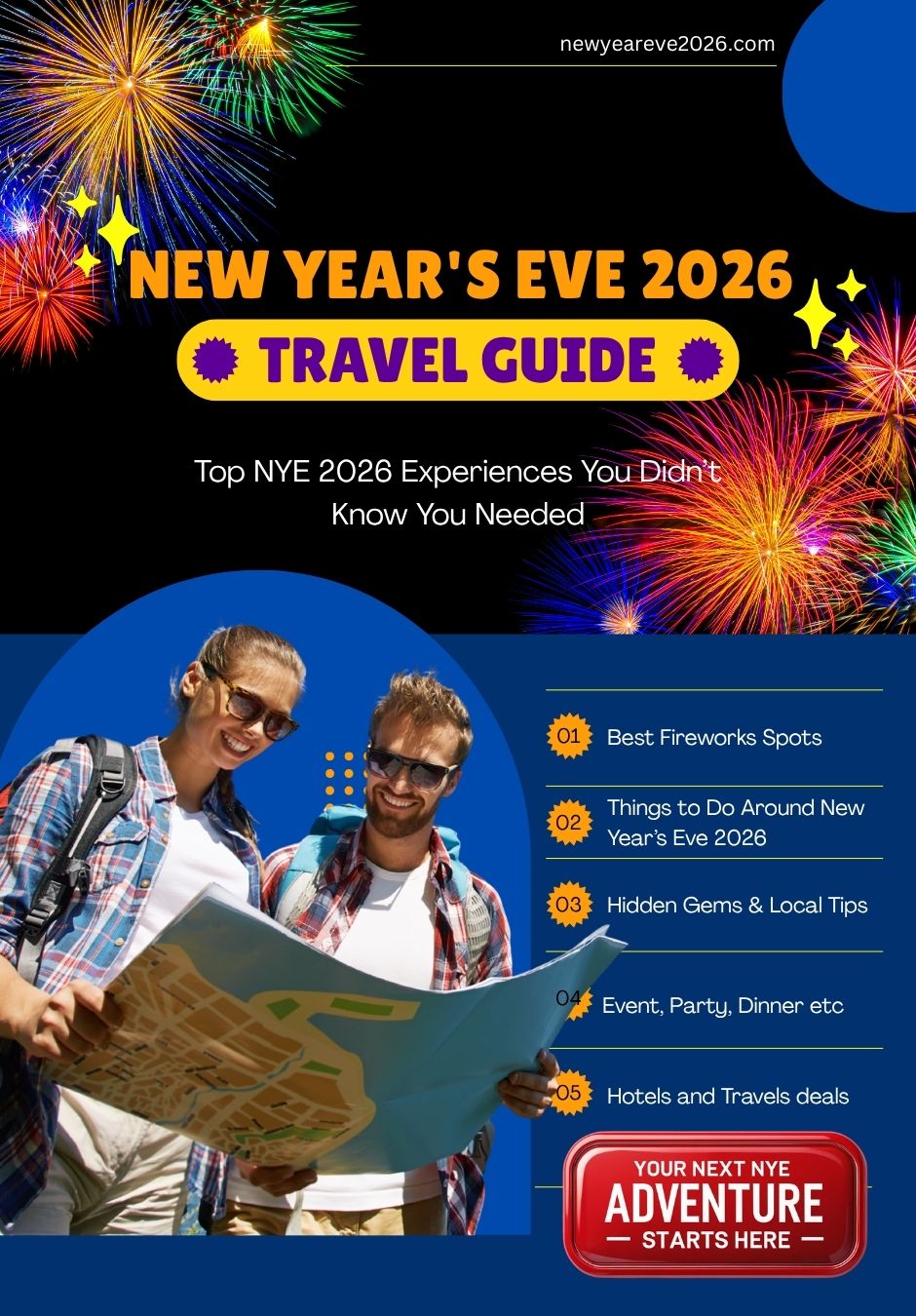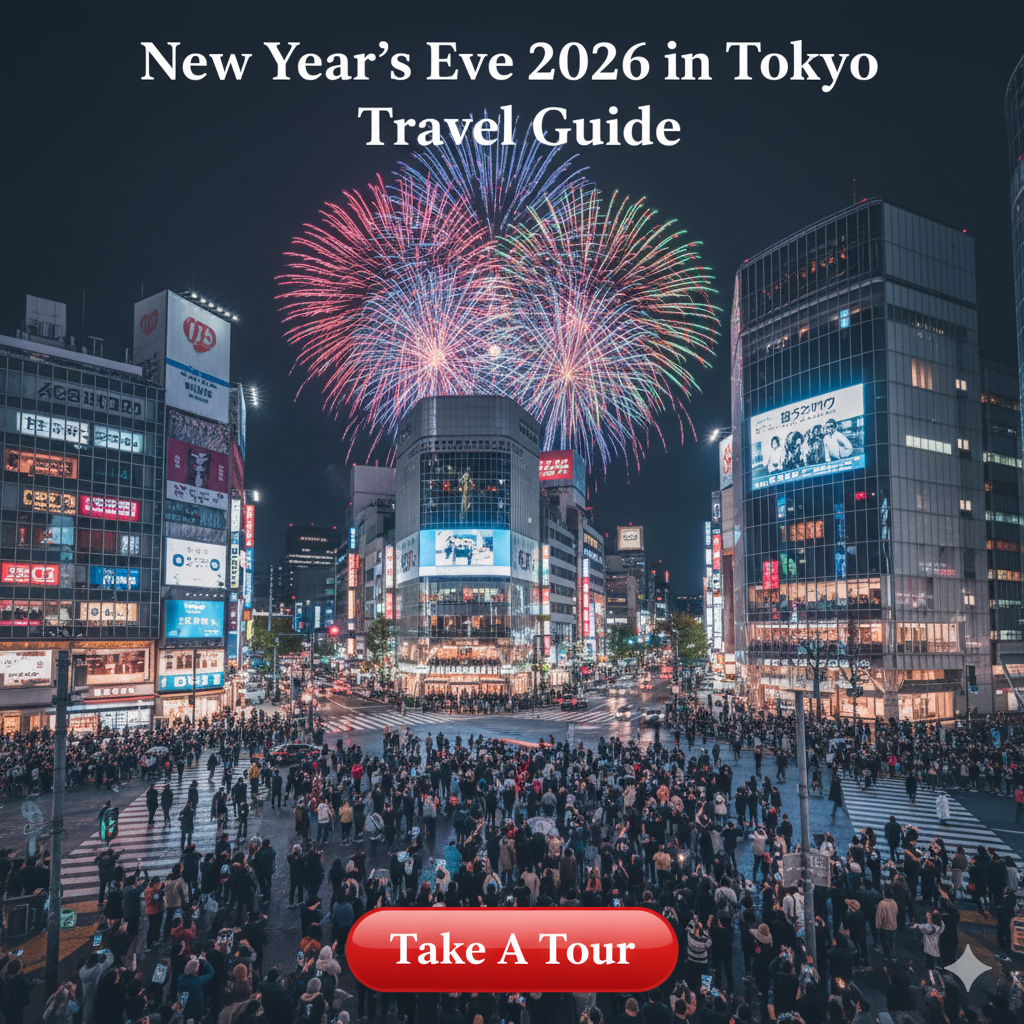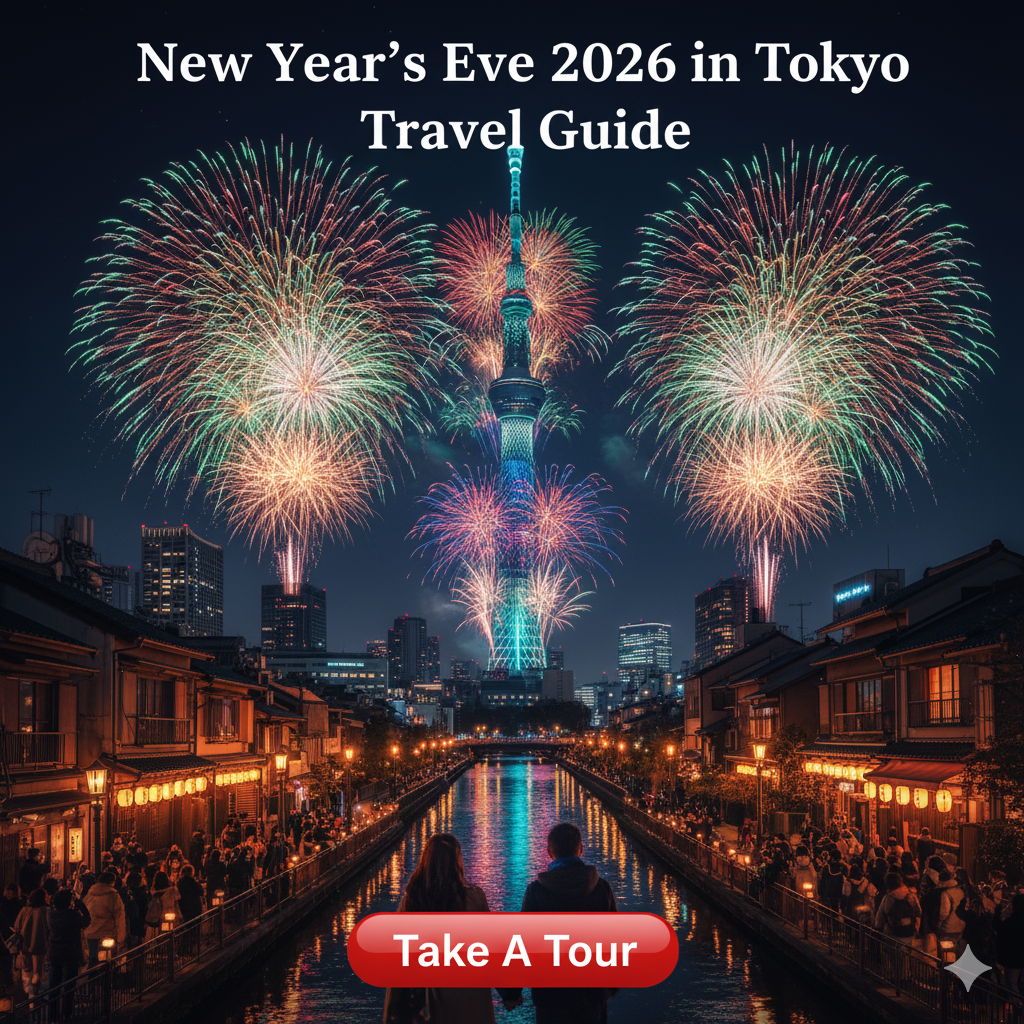There’s something spellbinding about Tokyo on the cusp of a New Year. As December bows out, the city aligns its neon pulse with the quiet ritualism of reflection—ancient temples stand illuminated beneath skyscrapers, trains hum with energy, and the streets shimmer with expectancy. Here, celebration is a balance of yin and yang: wild modernity colliding gracefully with centuries-old custom. In Tokyo, time doesn’t stop for New Year’s Eve—it transforms.
At sunset, the city hums. Lanterns flicker outside izakayas in Shinjuku, families queue at temples for the sacred first prayers, and crowds pour into Shibuya Crossing—a kaleidoscope of humanity mirroring the city’s unstoppable momentum. Tokyo feels alive, charged with a kind of electricity that is more than festive—it’s cinematic, spiritual, and deeply human.
New Year’s Eve 2026 in Tokyo, Japan Ultimate Guide, CLICK HERE
When the Night Hums Before Midnight
Even before dusk fully settles, Tokyo hums with ritual. Department stores in Ginza dim their signs; shrines begin last blessings; convenience stores stack osechi boxes (traditional New Year foods) and toshikoshi soba noodles. In neighborhoods like Asakusa or Ueno, lanterns glow, and children drag parents into yarn shops for charms.
Tokyo is not about mass street parties on December 31. Instead, the city’s observances interlock—families attend temples, locals walk from shrine to shrine, urbanites drift toward rooftop bars, and some head to stations destined for far‑flung hometowns. Yet in every lane and corner, discreet countdowns and whispers stir.
As twilight deepens, anticipation intensifies. Many people start the journey toward shrines like Meiji Jingu or Zojo‑ji, carrying small offerings or coins. The air smells faintly of incense, sweet sake, and the promise of renewal. If you intend to partake in Joya no Kane (the temple bell rite), scouting your shrine access and route in advance will help you arrive in peace.
Main Events & Countdown in Tokyo
Tokyo’s New Year’s Eve is famously diverse, encompassing everything from techno jungle parties to moments of serene prayer. The city caters to every rhythm: revelry beneath flashing billboards and silence beneath temple eaves.
Shibuya Crossing hosts the capital’s most kinetic countdown, a spectacle often likened to New York’s Times Square. Streets close to traffic as tens of thousands gather, phones raised high, waiting for the clock to strike midnight amid projected light displays and cheers. In 2026, expect another fusion of holographic visuals and outdoor DJ sets around Hachiko Square, painting the skyline in digital art.
In Roppongi Hills, luxury meets nightlife—with rooftop champagne parties overlooking Tokyo Tower’s illumination, live jazz on the 52nd floor of Mori Tower, and mingling crowds celebrating long past midnight. Meanwhile, Tokyo Skytree offers a more family-friendly alternative, transforming its observation decks into a luminous 360° lantern with citywide views of fireworks and illuminations.
But not all Tokyo celebrations are loud. Many locals and travelers alike flock to Zojo-ji Temple near Tokyo Tower for Joya-no-Kane (the Bell Ringing of 108), a sacred Buddhist ceremony marking the purging of human worldly desires. The rhythmic ringing of the bell feels hypnotic, ushering in the New Year with peace before fireworks embers dot the horizon.
Ritual of the Bells: Joya no Kane & Midnight Purification
At the stroke of midnight, temples across Japan ring their bells 108 times: each toll believed to purge one of the 108 earthly desires in Buddhist cosmology. In Tokyo, this ritual—Joya no Kane—resounds from temple domes and echoes across city room.
Zojo‑ji Temple, near Tokyo Tower, is one of the most well-known sites for this ritual. The temple organizes bell-ringing events open to the public (though tickets or timed entry may apply). The tolls begin slightly before midnight and extend into the new year. Elsewhere, smaller neighborhood temples offer quieter versions of the same rite—less crowd, closer intimacy. To participate respectfully, checking bell‑ringing schedules and venue rules ahead is recommended
Among the bells, people lean forward, coverings pulled high, heads bowed. Their breaths catch. And as the last note fades, the city moves—candles, offerings, kumade (good luck rakes), and bowed hands begin scattering into night.
 New Year’s Eve 2026 in Tokyo, Japan Ultimate Guide, CLICK HERE
New Year’s Eve 2026 in Tokyo, Japan Ultimate Guide, CLICK HERE
Fireworks & Illuminations
Tokyo doesn’t feature a singular, all-city fireworks display—the Japanese reserve grand pyrotechnics for summer. Yet, the city compensates with astonishing winter light shows and limited-edition fireworks scattered through the capital.
The Odaiba Rainbow Fireworks over Tokyo Bay are among the few true pyrotechnic displays of the season, featuring timed fireworks illuminating the bay alongside synchronized music and the glowing Rainbow Bridge. Visitors in nearby Hilton Odaiba, Aqua City, or the Decks Tokyo promenade enjoy cinematic views of fireworks reflected in the water.
Tokyo Tower’s own “Red Tower Illumination”, alongside Roppongi’s City View Lounge or the Ritz-Carlton’s top-floor bars, offers dazzling aerial perspectives of both Odaiba and the city’s midnight glow. Expect fireworks bursts, but also digital projections shimmering across high-rises, blending technology and aesthetics into something unmistakably Tokyo.
Where Tokyo Lights the Sky & the Soul
Unlike some global cities, Tokyo doesn’t rely on massive public fireworks on December 31. Instead, light bursts are often regional, private, or modest, while the real spectacle lies in illuminated towers, digital projections, landmark facades, and panoramic vantage points.
From Azabudai Hills, the Tokyo Tower may glow new year hues. From Roppongi Hills’ observation decks, you can see scattered bursts in the distance, though the real delight is in the cityscape itself. If you’re seeking a high perch above the city glow, reserving observatory or panoramic bar access ahead is smart.
Neighborhood shrines like Senso‑ji may stage small fireworks or lantern releases over their grounds. Meanwhile, in districts like Odaiba, occasional bay fireworks over Tokyo Bay accompany countdown events by harbors, cruise ships, or waterfront complexes.
At midnight, Tokyo’s sky is never truly dark. Neon towers, shifting LED facades, and the silhouette of skyscrapers frame bursts, stars, or drones depending on local spectacle. From some vantage points, the city feels like a living constellation.
New Year’s Traditions: The Heartbeat of Japan
Beyond the parties, the Japanese New Year—or Shōgatsu—is steeped in ritual and meaning. As midnight arrives, millions begin Hatsumōde, the year’s first shrine or temple visit, seeking renewal, protection, and luck.
Meiji Shrine, surrounded by Shibuya’s forest, draws vast yet remarkably peaceful crowds who shuffle quietly toward ancient gates lit by flickering paper lanterns. At temples, the air is thick with incense; fortunes (omikuji) are chosen, and amulets (omamori) purchased for blessings. The mood is reverent—more spiritual than loud, an essential contrast to Tokyo’s earlier revelry.
In quieter corners, ramen shops stay open late for steaming bowls of toshikoshi soba, a thin buckwheat noodle meal symbolizing the cutting away of difficulties from the past year. It’s a deeply Japanese custom, simple and grounding—a meal marking the crossing from the old year into the new.
Things To Do Around NYE 2026 in Tokyo
To fully experience Tokyo’s duality, dedicate the preceding days to exploration. Tour the Asakusa district, where Sensō-ji Temple glows beneath red lanterns, or take in the winter gardens of Shinjuku Gyoen, peaceful even amidst the city’s bustle.
Seek out immersive light events, like Shibuya’s Blue Cave—a tunnel of 800,000 LED lights that turn the streets into a sea of luminous blue. For those craving something offbeat, the Haneda Edo Festival at Haneda Airport resurrects Japan’s Edo-era traditions with performances, kimono parades, and street foods in a bygone setting.
Party seekers can head to Roppongi, Shinjuku, or Ginza, where clubs host NYE-themed nights ranging from underground house music to champagne soirees. Popular options for 2026 include Womb, AgeHa, Ce La Vi, and new omotenashi-inspired rooftop lounges hosting bilingual MCs and digital drone shows.
If nightlife’s your way of greeting the New Year, browse experiences here.
Best Fireworks Viewing & Countdown Spots
Best Fireworks Viewing & Countdown Spots in Tokyo NYE 2026, CLICK HER
Though Tokyo’s fireworks are modest, its skyline offers magical perspectives.
-
Odaiba Seaside Park: The best free viewpoint for fireworks and Rainbow Bridge lights, perfect for couples and photographers.
-
Tokyo Tower Observation Deck: Tickets sell fast, but the panoramic perspective of the illuminated city is worth every yen.
-
Roppongi Hills Sky Deck: Open-air view of the entire cityscape—where you can see fireworks bursts from Odaiba to Yokohama.
-
Sumida River promenade: A tranquil alternative near Asakusa for slower rhythms and illuminated temple façades.
Best Vantage Points: Where to See & Be Still
-
Tokyo Skytree & Roppongi Hills Decks: Panoramic views over Tokyo’s sprawl; from such heights you may see flares in distant wards.
-
Shibuya Crossing & Nearby Rooftop Bars: The pulsestreet energy anchors you in the heart of the city.
-
Zojo‑ji / Tokyo Tower precinct: Combines shrine ritual with tower-lit vistas.
-
Odaiba Waterfront: If a fireworks display is active, the bay view provides reflection and scale.
-
Shrine rooftops & garden terraces: Some shrine complexes open upper floors for viewing. Seek permissions or special passes early.
If your goal is height and clarity over chaos, exploring high‑floor bars or observation lounges early is crucial. In crowded zones, arriving before 10 PM—or earlier—makes a profound difference in sight and experience.
Where to Stay in Tokyo
As the world’s largest metropolis, location shapes your experience:
-
Shibuya or Shinjuku: For nightlife, dining, and the iconic urban countdowns.
-
Asakusa: For cultural travelers seeking Hatsumōde within walking distance of Sensō-ji.
-
Odaiba: For bayfront fireworks and romantic waterfront hotels like Hilton Odaiba and Grand Nikko Tokyo.
-
Roppongi or Ginza: High-end stays with skyline views and luxury NYE galas.
Discover Tokyo’s finest NYE stays and deals here.
Romantic New Year’s Experiences in Tokyo
Celebrate love and renewal Tokyo-style: a private dinner under the illuminated Tokyo Tower, a stroll through the glowing gardens of Rikugien, or a midnight cruise on Tokyo Bay. Some couples opt for quiet reflection at Zojo-ji Temple, hand in hand under its towering pagoda. For sunrise romantics, the first dawn of the year—Hatsuhinode—from Tokyo Skytree or Mount Takao stands among Japan’s purest and most spiritual traditions.
Budget-Savvy Celebrations
Tokyo’s wonder doesn’t demand extravagance. Public countdowns at Shibuya Crossing, temple ceremonies, and Odaiba’s fireworks remain free. Street food stalls along Asakusa and Shinjuku serve late-night yakitori and sweet red bean pancakes for less than the price of one flute of champagne elsewhere.
Take advantage of the extensive subway system—Tokyo Metro runs all night on New Year’s Eve—making it possible to hop effortlessly from Shibuya’s roar to Meiji’s tranquility, all without missing a moment.
Hidden Gems & Local Tips
-
Visit the TeamLab Planets installation just before NYE closes for surreal digital immersion before the city’s own light show begins.
-
Climb Mount Takao for the first sunrise of 2026—locals hike in the early hours, and from the summit, the city’s vastness glows below.
-
At midnight, skip crowds for serenity at Gotoku-ji Temple, rumored to be the birthplace of Japan’s “maneki-neko” (waving cat).
-
If you’re near Tokyo Bay after fireworks, enjoy Hot Spring Spa Oedo-Onsen Monogatari’s late-night session—a perfect warming escape.
-
Early in the evening, consider reserving rooftop or observatory bar access overlooking Tokyo Tower or Roppongi Hills to secure clarity and comfort during the shift.
-
For spiritual resonance and deep presence, check Joya no Kane bell‑ringing schedules at Zojo‑ji or neighborhood temples and plan your shrine approach accordingly.
-
To see the cityscape bloom in neon and light, explore panoramic observation or high‑floor bar listings in Tokyo early—those with skyline views fill quickly.
-
When planning your night’s path—from dinner to shrine to view—booking dining near Tokyo’s major shrines or observatories ensures you remain close to the pulse.
-
To feel Tokyo’s after‑midnight hum, look up late‑open jazz bars, cafés, and izakaya in neighborhoods like Ebisu, Koenji, or Shimokitazawa and map your late walk.
FAQ: New Year’s Eve in Tokyo
Are there large-scale fireworks in Tokyo on NYE?
Yes, smaller displays such as Odaiba Rainbow Fireworks light the skyline, but most focus is on illuminations and countdowns.
Do locals celebrate in the streets or at shrines?
Both—crowds gather in Shibuya for parties and at temples like Sensō-ji or Meiji Shrine for Hatsumōde prayers.
Is public transport available on NYE?
Yes, Tokyo Metro, JR Lines, and buses run overnight special services.
What should I wear?
Bundle up! December nights are crisp, averaging 4°C–8°C. Warm layers and gloves are essential for outdoor events.
Suggested NYE Itineraries in Tokyo
3-Night Classic Escape:
Arrive December 29th and explore Tokyo’s neon corridors—Ginza by day, Shibuya by night. Spend December 31st at Zojo-ji Temple’s bell-ringing and follow with Shibuya’s electric countdown. Start New Year’s Day fresh at Meiji Shrine’s Hatsumōde, sipping amazake as the sun rises through sacred torii gates.
5-Night Cultural & Modern Journey:
Weave Tokyo’s contrasts: Visit Asakusa’s temples, Nabemono hot pots in Kappabashi, and vibrant Roppongi bars. Cruise Tokyo Bay for the fireworks, then retreat to a luxurious stay near Marunouchi. Greet 2026 with a sunrise from Mount Takao before immersing in art at Mori Museum the next day.
Cultural Threads & Traditions That Shape the Night
Beyond bells and light, what defines Tokyo’s New Year Eve are traditions woven through everyday life. Before December’s end, many families engage in Ōsōji, a thorough cleaning to purify the home for the new year. Homes and shops scrub floors, clear clutter, sweep thresholds.
By nightfall, some businesses close early or shutter entirely. Trains may reduce service—so planning transit ahead is a necessity in Tokyo’s 24/7 image.
The turning of the year is not just counted—it is honored. At shrines, people purchase omikuji (fortunes), hang them, or tie them to racks; they offer coins, prayers, and gratitude. Decorative kumade or Daruma dolls await at stands near temples. The atmosphere is reflective, reverent, and celebratory.
In Tokyo, the new year dawns not in rush, but in roll: slow first steps into lines, prayer in dim lanternry, market stalls flickering open, temple grounds expanding with new crowds.
Closing Reflection
In Tokyo, time bends gracefully. The old year dissolves like incense smoke at Sensō-ji, even as LED screens in Shibuya flash promises of tomorrow. To end a year here is to witness motion itself—ancient bells, digital fireworks, and millions of footsteps crossing through a single illuminated moment.
If there’s a city where the future greets you with ceremony and wonder, it’s Tokyo.
Begin your New Year at the heart of Japan’s heartbeat

